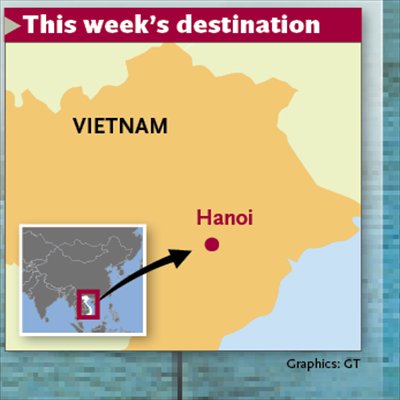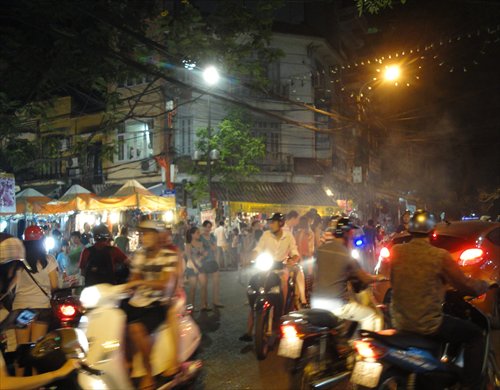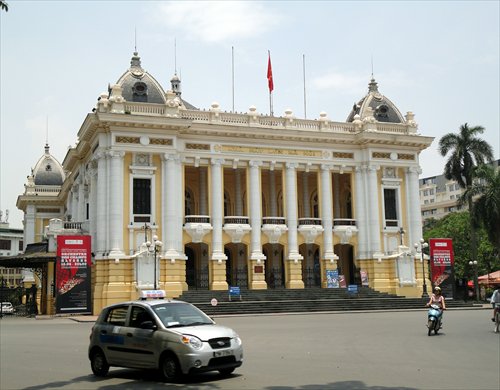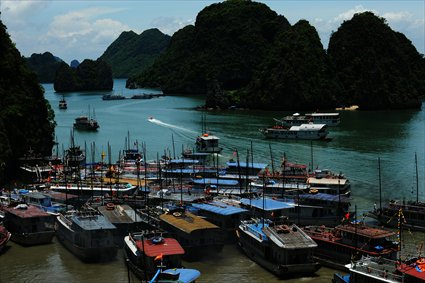Holiday Hanoi

This week's destination

Night scene of Hanoi Photo: Hilton Yip/GT

The Hanoi Opera House Photo: Hilton Yip/GT

View of Ha Long Bay Photo: CFP
When you look at Vietnam on a map, you can't help noticing its distinctive form as a long, slim S-shaped coastal region facing the South China sea. This compacted shape belies a nation of over 90 million and is packed with dynamic cities, natural beauty and culture.
Up until last year, I'd never been to Southeast Asia so I decided to remedy that with a three-country trip. The first country on my list, Vietnam, was a deliberate choice as I'd long wanted to see Ha Long Bay, just off Vietnam's northeastern coast and filled with thousands of karst islets.
I started from the North, flying into Hanoi from Taiwan, and then making a side trip to Ha Long Bay.
Hanoi is the nation's undisputed political center, being the current capital as well as the capital of pre-unification North Vietnam and an imperial capital. This gives it a reputation as a city where a more traditional and reserved mind-set prevails, in contrast to the possibly more well-known Ho Chi Minh City (HCMC). It's a comparison not so dissimilar from China's Beijing-Shanghai dynamic.
The capital city is definitely historic, featuring a wealth of sites ranging from an imperial citadel to French colonial-era buildings to a 944-year-old Confucius temple and a 1,400-year-old pagoda. Additionally, you have the Old Quarter, a maze of historic neighborhoods in the city center filled with shops, restaurants, and hotels. There are several museums too, including the national history museum, a military museum, and a revolution museum.
Far from a sleepy city, Hanoi is full of noise, especially traffic of the noisy motorized two-wheeled kind. The streets are filled with motorcycles which provide a constant symphony of honking and rumbling throughout the day. I lived in Taipei where scooters and motorcycles make up a big part of traffic as well, but I'm confident enough to say Hanoi has Taipei beat both in numbers and decibel level.
One of the busier places is the Old Quarter, which as its name suggests, is an old section of Hanoi and a fine place to walk around, shop, and sightsee. The streets are filled with shops, many of which have their goods displayed out in the open. Vendors wearing conical hats walk around carrying loads balanced on poles slung across their shoulders, while cars and vintage motorcycles rumble along the road. While there are many hotels, souvenir stores and restaurants geared for tourists, there's a refreshing lack of Western chain stores. Instead, there are many local restaurants and coffee shops, where you'll see lots of Vietnamese sitting on stools eating and drinking.
One important thing to note is that several streets still follow tradition and only have stores selling one main item, such as clothes or shoes. I learned this the hard way when I turned left from my hotel in the quarter one evening and walked down a street, looking for a place to eat, only to realize every single store sold clothes. The next day I turned right and found numerous eateries, bakeries and cafés.
On weekend nights, it gets even livelier as an outdoor night market is held along an entire street running through the quarter. There are tons of locals and tourists browsing the heaps of clothes, food and souvenirs sold by vendors in covered stalls. Traffic is barred with only pedestrians allowed.
A glimpse into the past
Even as a tourist, it's impossible to ignore Vietnam's turbulent history. The country fought two wars in the 20th century against much larger, stronger and developed nations and won, breaking free from French colonialism and outlasting the US.
Several of Hanoi's most prominent sites of interest are related to the war. The Military History museum features jet fighters, helicopters, tanks, and cannons from the Vietnam War outside while inside there are mostly displays about ancient wars. Its most striking external exhibit is a large pile of wreckage from US F-111s and B-52s, a massive 8-engined bomber still used today, that had been shot down during air raids.
Right next to the military museum is a reminder of a different history - the Imperial Citadel. This was the palace of Vietnam's emperors before the 19th century, and though most of the place is still being renovated it is still a sight to see. Opposite the museum is a park with the statue of the great Soviet socialist statesman Lenin, probably one of the few remaining in the world.
One of the more infamous sites is the Hoa Lo prison or "Hanoi Hilton" as it was sarcastically dubbed by US soldiers. The prison has a sinister history, having originally been used to imprison Vietnamese agitators by the French during the colonial era. You can walk through the group cells and dungeons for those in solitary confinement, while looking at life-sized plastic prisoner mannequins chained to beds and the floor, as the real prisoners were. Among the main exhibits is an actual guillotine. Much taller and narrower than I expected, it was the first time I'd set sight on this notorious killing machine. Black-and-white photos next to it of hapless Vietnamese prisoners and their cleanly decapitated heads testified to its deadly efficiency.
Meanwhile there was a rather upbeat section - one about US prisoners captured during the Vietnam War. The most famous of these prisoners is John McCain, the US senator and former Republican presidential candidate. This section featured things used by the prisoners including musical instruments, sports equipment and drawings, as if to emphasize a pleasant captivity.
Even though France's colonial rule was ended by force, its influence is still apparent in architecture, religion, and food. Elegant mansions and buildings, painted in a distinctive yellow, can still be seen, and ironically are mostly used by the government. The Opera House and St. Joseph's cathedral are two of Hanoi's more well-known French landmarks. The Opera House is grandly located at a roundabout, about 10 minutes southeast from the Hoan Kiem lake and well worth the walk. Nearby are the national history museum and the revolution museum, both of which are former French buildings as well. The history museum features exhibits spanning Vietnam's history over the past 1,000-plus years in a well-maintained setting.
Hoan Kiem lake is a popular place, especially at night when it's full of tourists and locals. In the lake's center stands the Turtle Tower, while the Jade Mountain Temple is on the east shore. The lake is a key site of one of the country's famous legends - a turtle was said to have emerged and taken the sword of Emperor Le Loi while he was on a boat on the lake. Hoan Kiem means "return of the sword." The emperor reasoned that the turtle was reclaiming the sword - reminiscent of King Arthur's Excalibur - which was said to have special powers and origins. There is even a West Lake, which is much bigger than Hoan Kiem and lies further to the north.
Ho Chi Minh, Vietnam's revered independence leader, still has a monumental presence in the city. "Uncle Ho," as he's referred to by many Vietnamese, can be seen inside his gray mausoleum at Ba Dinh Square during the daytime. At intervals, special guardsmen march to and from their posts with elaborate ceremony. Nearby are the Presidential Palace which Ho refused to live in, the stilt house which Ho actually lived in, the One-Pillar pagoda, which rests on a pillar in the middle of a large pond, and even a museum dedicated to Ho.
The Temple of Literature is probably the city's most well-known, having been built in 1070 and served as an ancient university up until 1802. It seems fitting given its main purpose was to worship the Chinese scholar and sage Confucius. The temple is in a large compound, with gardens, several courtyards and halls. Chinese inscriptions can still be seen on the gates and steles, a testament to when Chinese script was used hundreds of years ago.
Ha Long Bay
As interesting as Hanoi is, there are other worthwhile places nearby, specifically one that's a few hours away.
Ha Long Bay is the country's most famous sight and obviously a popular destination for visitors. The imposing limestone karsts and islets are visible from the shore, and become more "dense" as you head offshore. Often topped with lush, green vegetation, the islets form a beautiful marine "jungle" with lots of small coves and beaches. There are other places in the region that also have similar beautiful offshore islets, but I don't think they can compare with Ha Long Bay in terms of numbers and atmosphere.
I did an overnight boat cruise to take in Ha Long Bay so I could have more time to enjoy its sights. Tourist boats with large sail masts similar to those of old-time junks were also a frequent sight, but instead of detracting, it added to the bay's beauty and atmosphere.
Of course, you don't go there just to sit on a ship and view the scenery. We were also able to go onshore to explore a giant cave, hike a small hill with great views, and kayak in a sheltered cove. The Sung Sot cave was particularly spectacular. Featuring attractive and peculiar rock formations, jagged stalactites, and different colored lights lighting up the place while being restrained enough to avoid being too garish it was large enough to fit an entire village inside.
After Hanoi and Ha Long Bay, I went south, first to the former capital of Hue in the central part of Vietnam, and then HCMC, the country's economic center. Those places also had their special attributes, but we'll leave that for another article.
Rules of Thumb
How to go:
By air: Fly direct from Beijing, Chengdu, Shanghai, Hong Kong, or Guangzhou to Hanoi.
By train: Take the train from Nanning, Guangxi Zhuang Autonomous Region, which goes to the Vietnam border and you can connect to another train that goes direct to Hanoi.
Practical info:
You can get a free day tour with university students speaking fluent English or other languages from Hanoi Free Tour Guides or similar organizations.
Vietnam's currency, the dong, has an exchange rate of about US$1 - 21,090 or 1 yuan - 3,450.
What to eat:
Bun Cha, barbeque pork served with rice noodles and fresh herbs
Pho, traditional Vietnamese soup noodles served with meat. Pho bo is beef, while pho ga is chicken.
When to go:
Hanoi has a rainy season (May - September) with hot summers and a dry season with moderate winters. During the rainy season, it is hotter and there is heavy rain and typhoons. From September to December is usually the most pleasant time to visit.